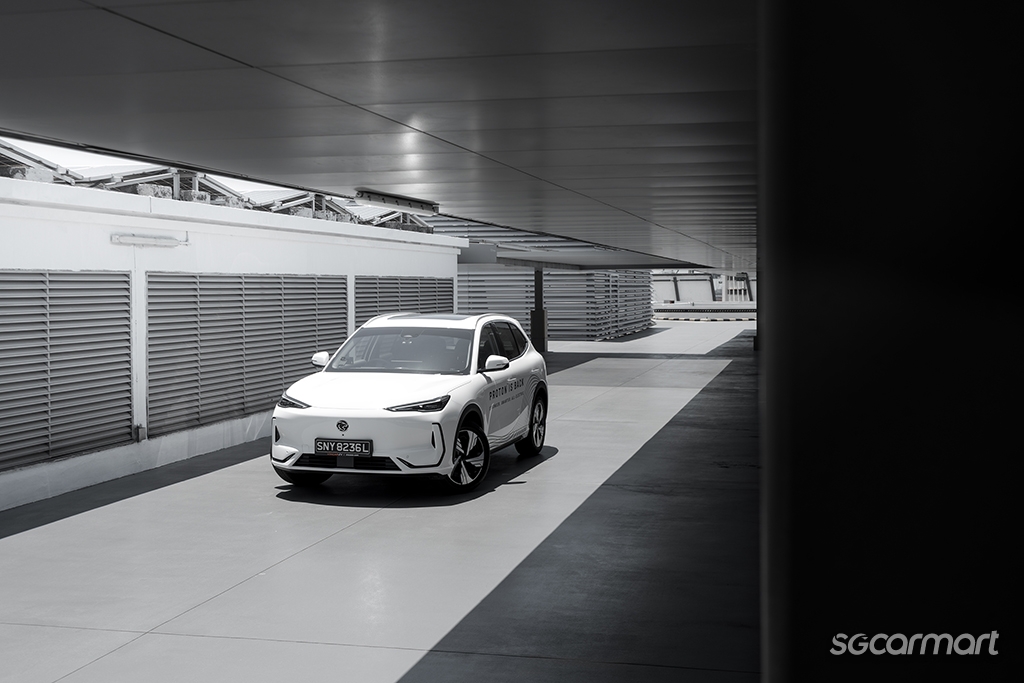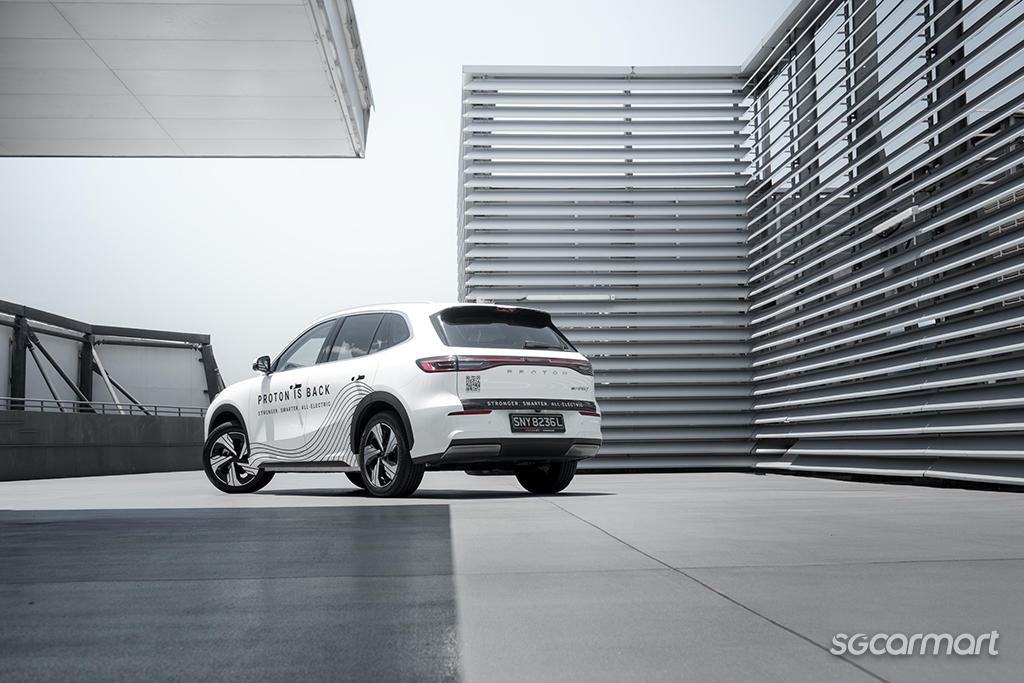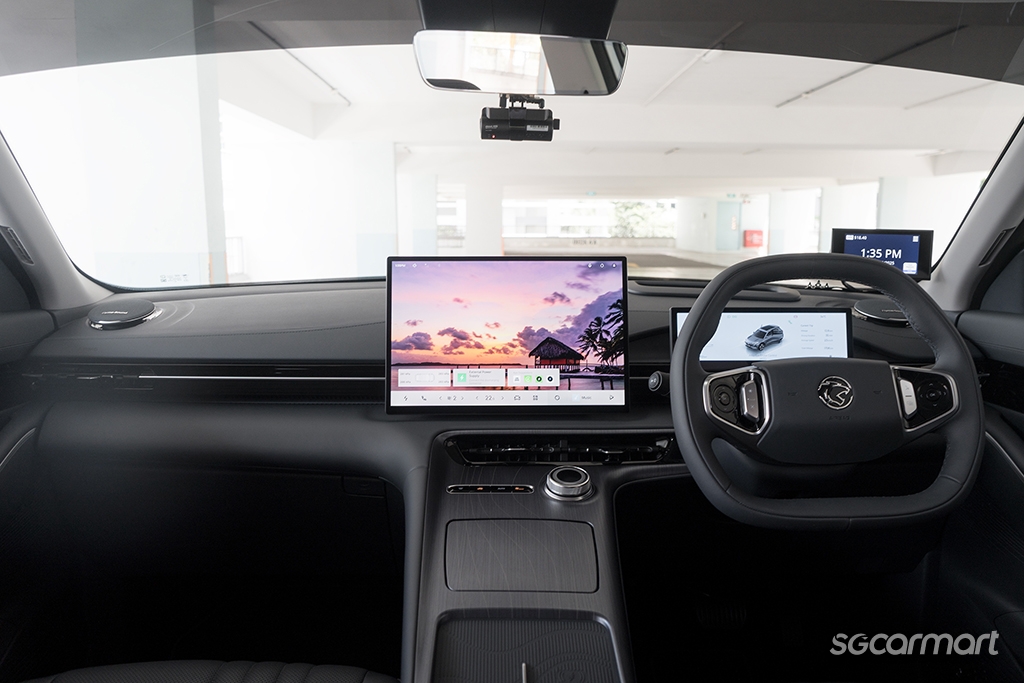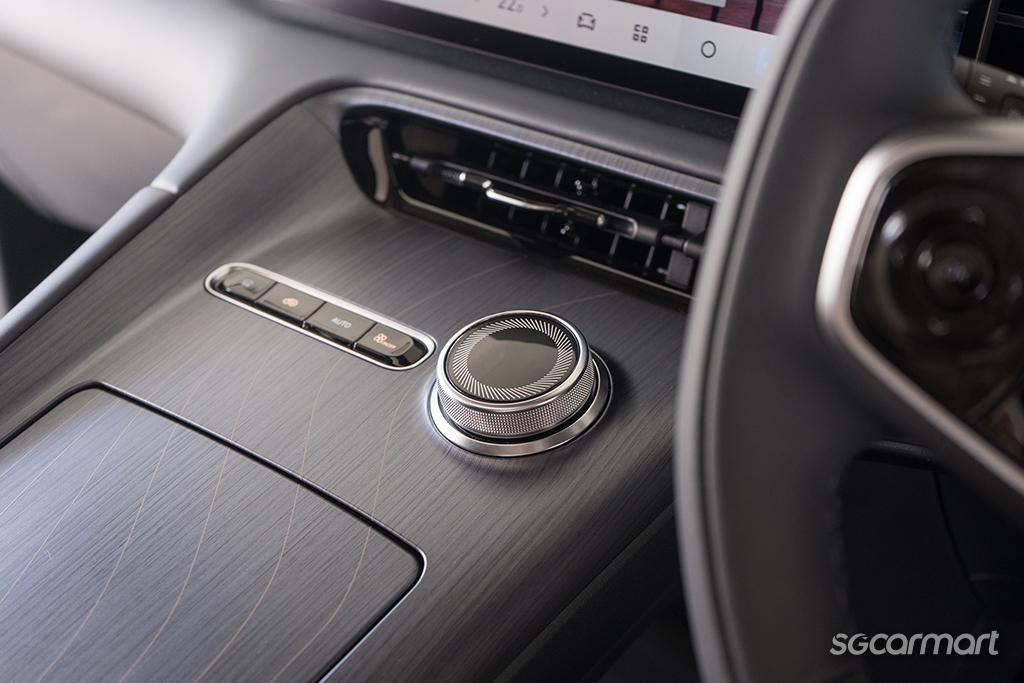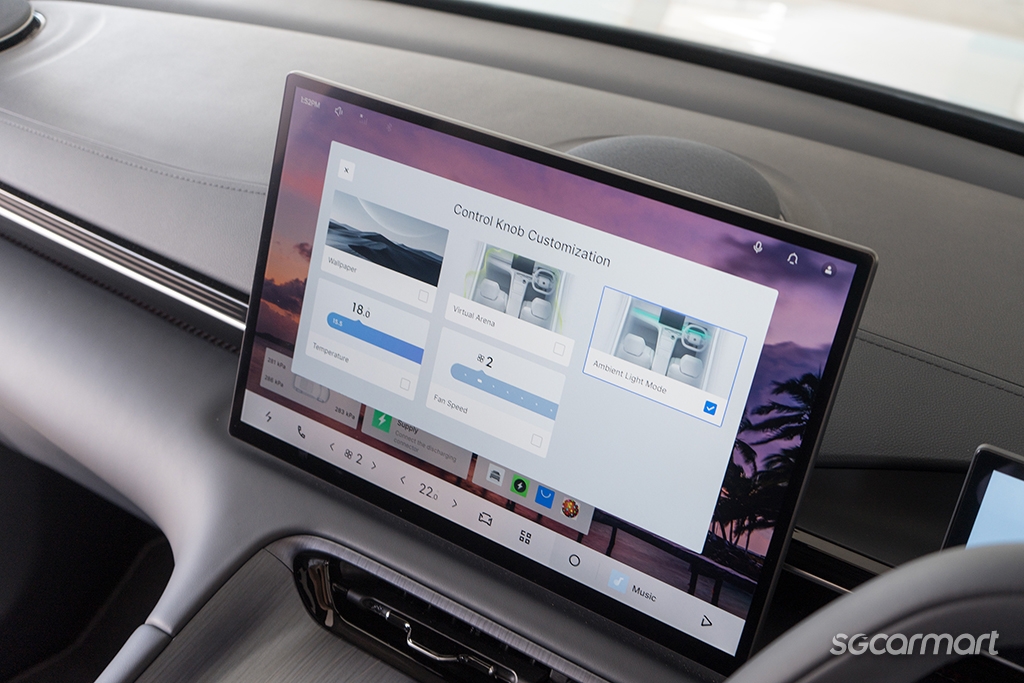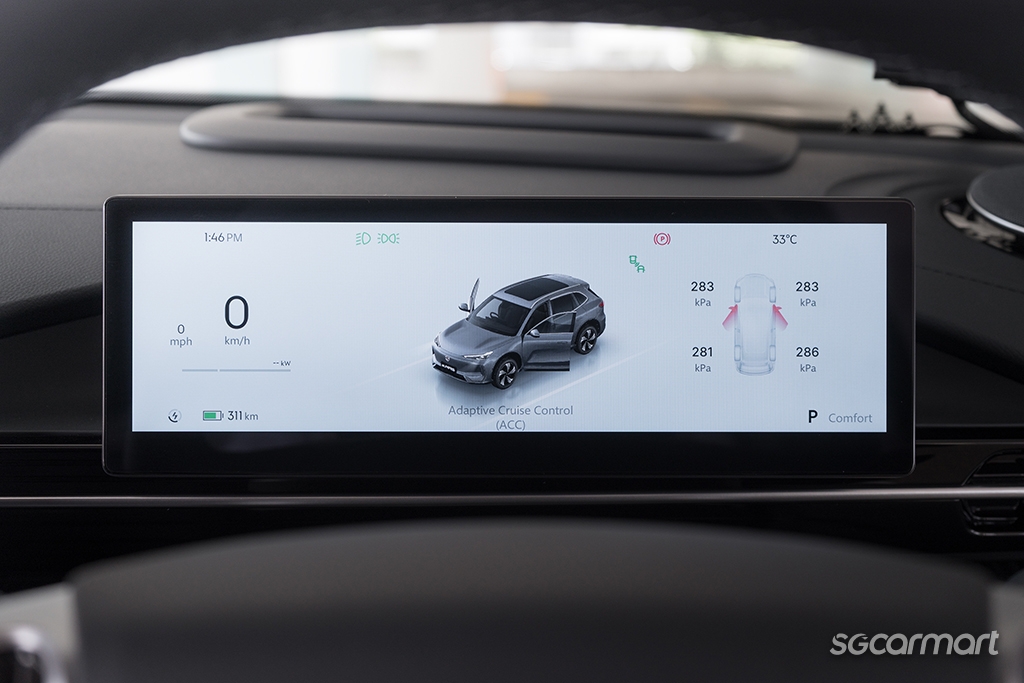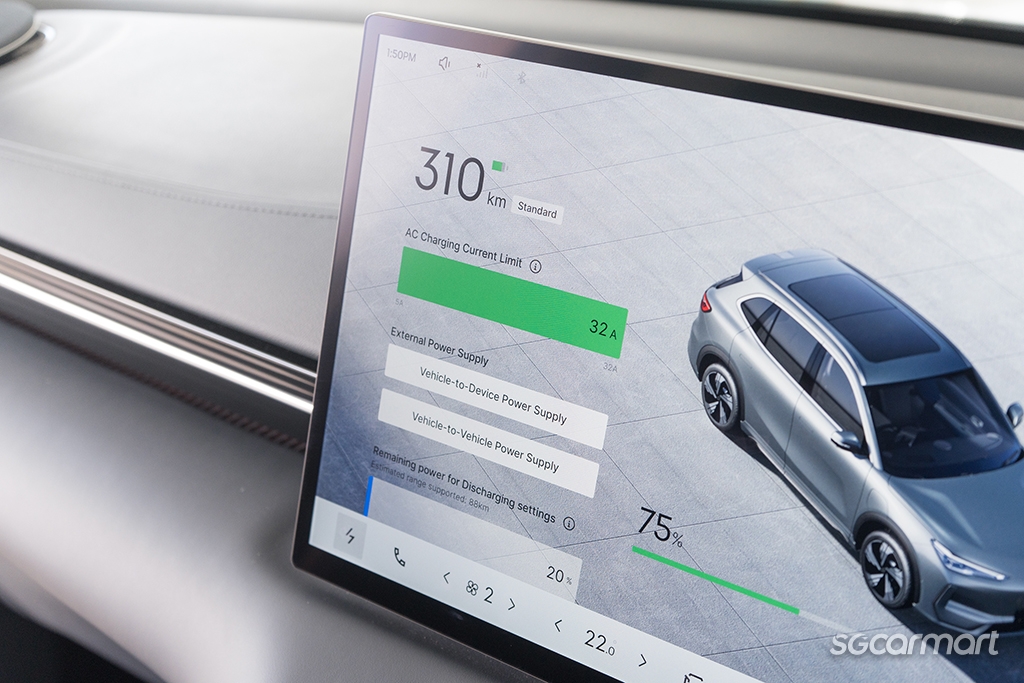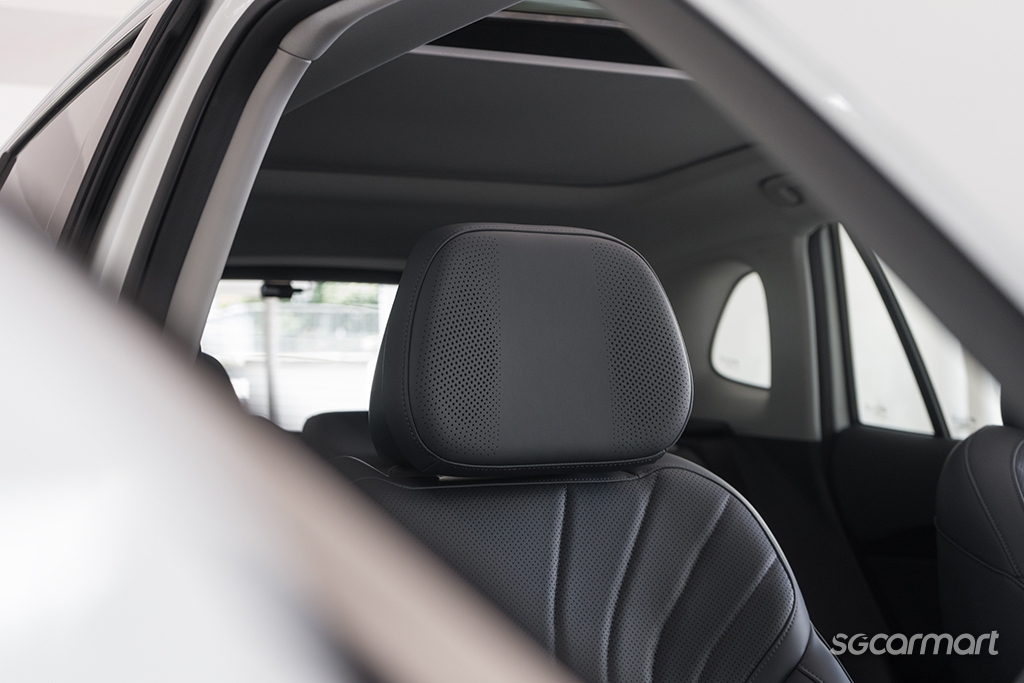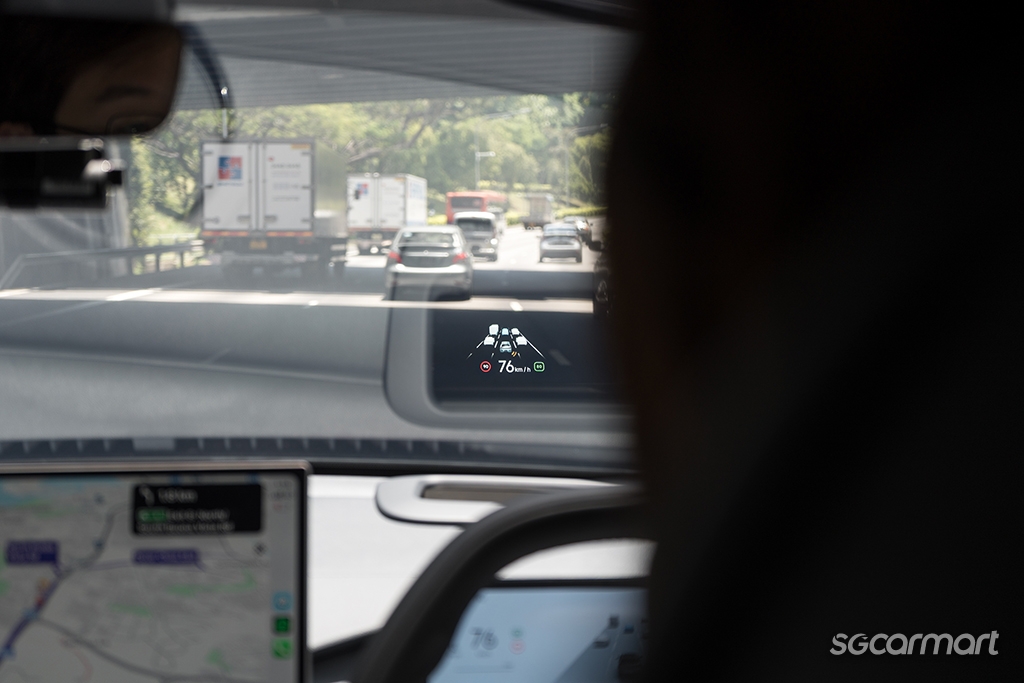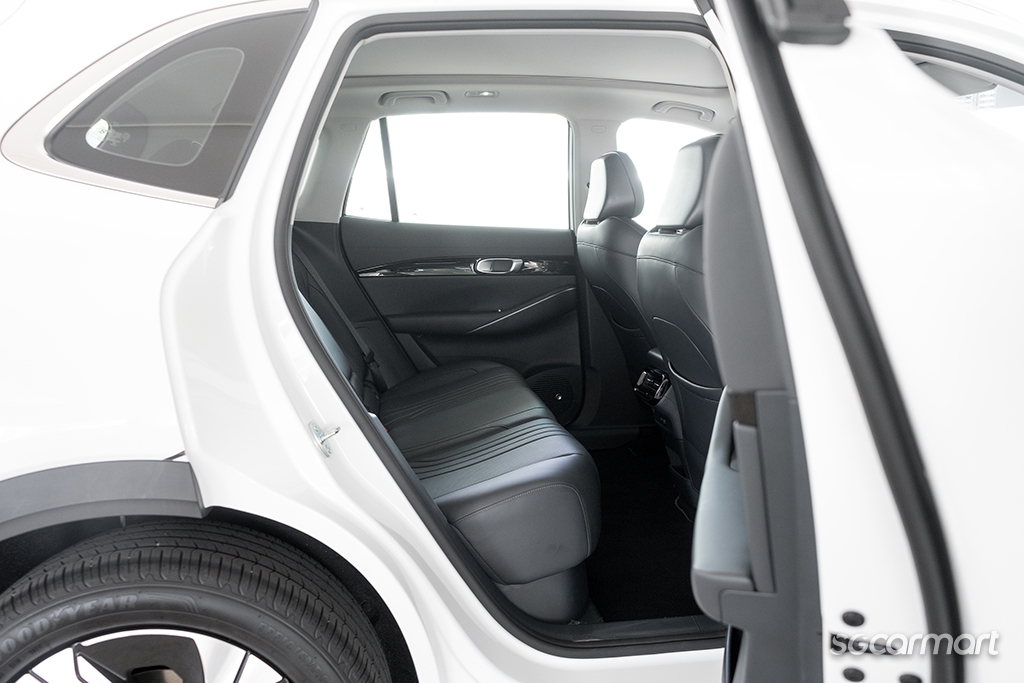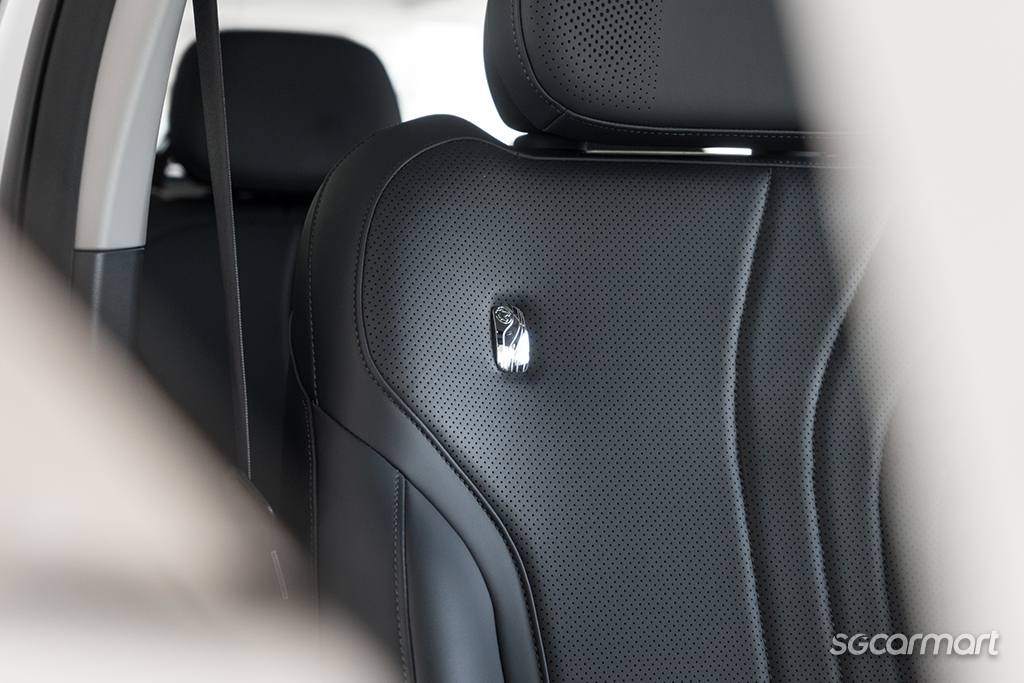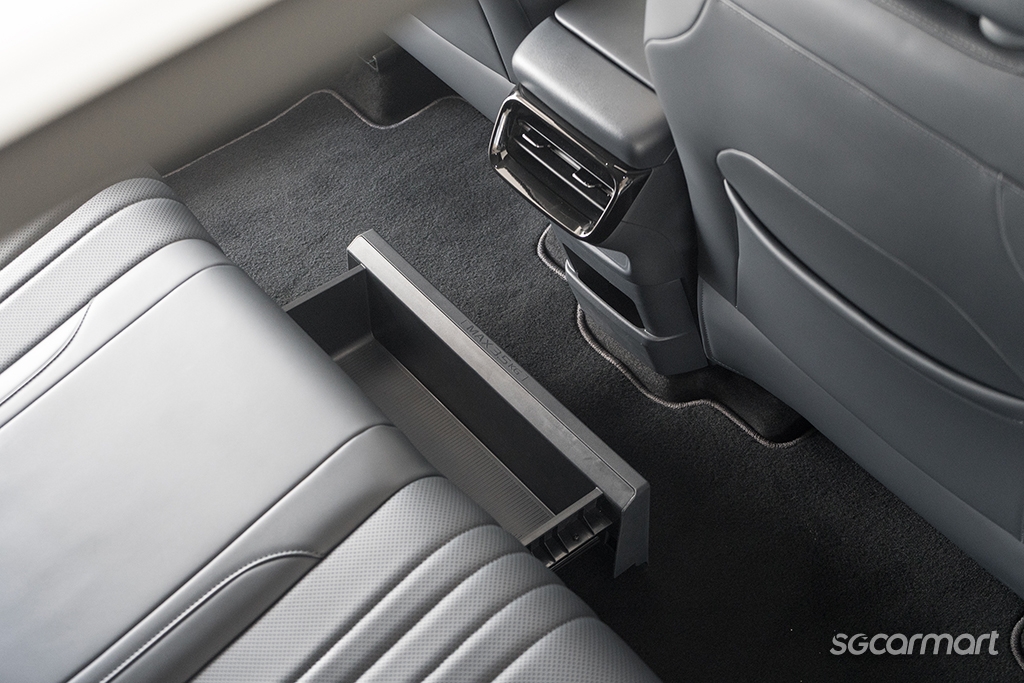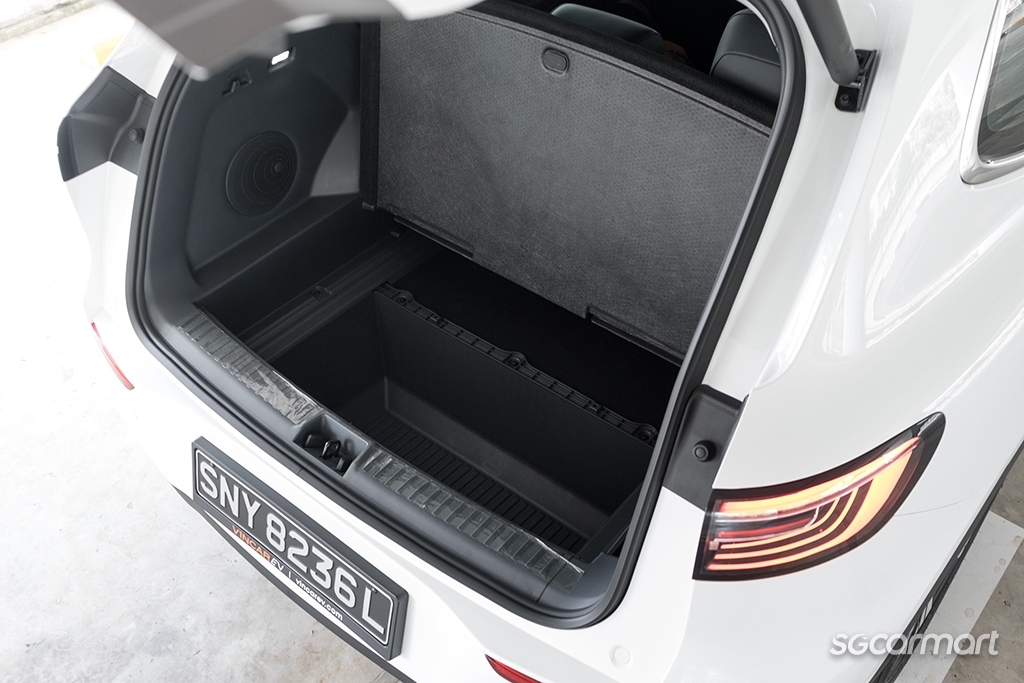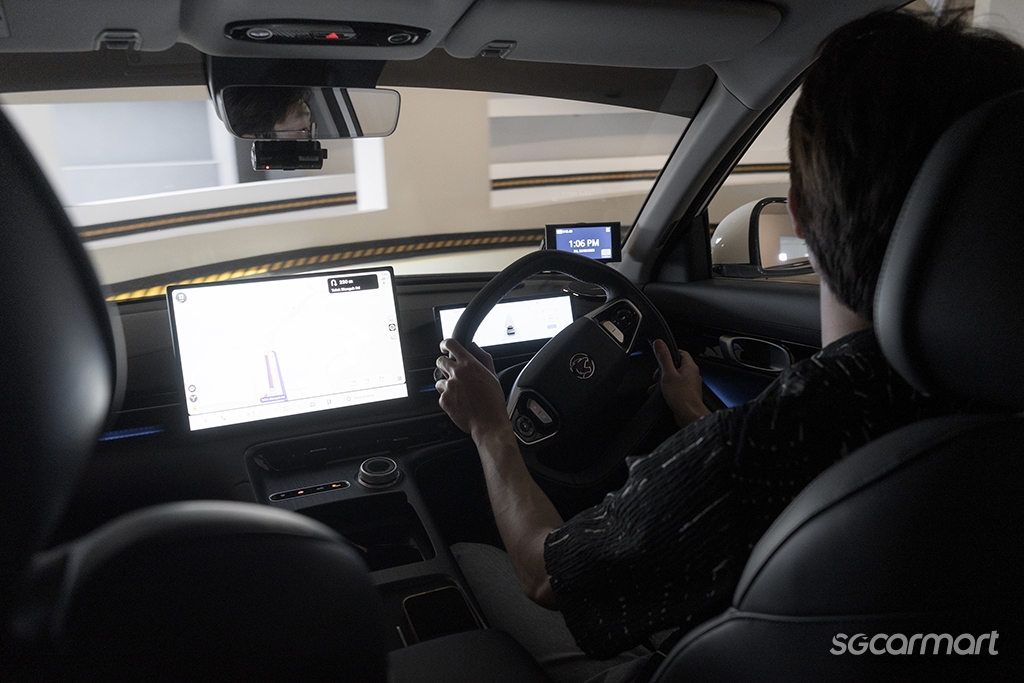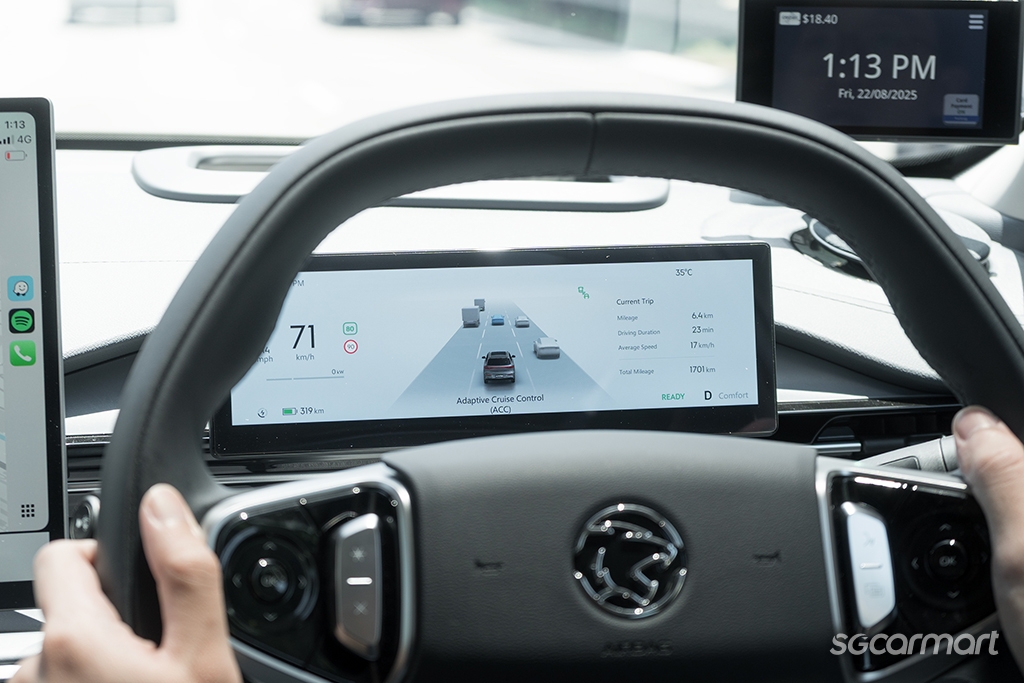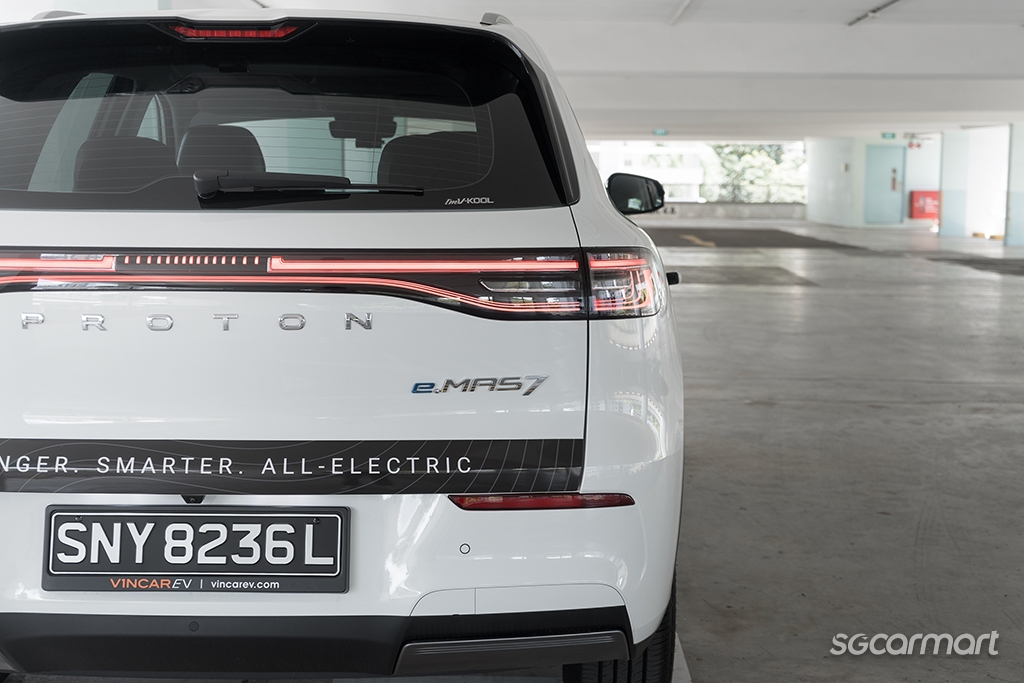Proton e.MAS 7 Premium 60.22kWh Review
30 Aug 2025|16,442 views
What We Like
Calming and charming cabin; spacious rear bench
Right amount of power
Generous level of equipment
Manageable size
Commendable electric range
What We Dislike
Steering feels too light in its default setting
Feels a bit wafty at lower speeds
Overly-chatty ADAS
Singapore's bubble-like environment is often not reflective of the state of affairs in the wider world beyond. Malaysia's national carmaker, Proton, is a good example.
Chances are that the first-generation Saga or even the Exora MPV (released in 2009) will come to mind when most Singaporeans today think of the brand. But Proton is no longer the brand it was, and 2025 should give these folks a good wake-up call.
First bought into with a nearly 50% stake by China's Geely Group in 2017, the carmaker is now making a splashy re-entry with the e.MAS 7 - an electric SUV whose roots are arguably not all that Malaysian, and whose undeniable polish puts it in good stead to establish Proton's name here again.
There's the indisputable presence of the car, for starters.
One might jump to lump the e.MAS 7 within the same compact category as the BYD Atto 3 and MGS5 EV - technically still its direct rivals - but by the measuring tape alone, its real contemporaries are the notably larger Aion V or Kia EV5.
In fact, what greets you is an SUV that stands out more for its size than design. It's not that the e.MAS 7 is controversially styled, to be clear; its feline front end is quite sharp-looking thanks to those slim head lights, with the black outlines of its lower bumper almost resembling whiskers. Chunky black wheel arches also give it a slightly rugged aesthetic.
Yet the sum of all these parts is a bit more vanilla than what we've seen within the electric SUV space of late. That's no issue in itself, and certainly no issue for those who want to fly a bit more under the radar - but it's not anything groundbreaking from a design standpoint.
The (upmarket) interior is where the e.MAS 7 becomes a bit more interesting, with credit due to a number of atypical touches.
Heavily digitalised interfaces are all the rage in EVs, and while the e.MAS 7 sticks dutifully to this modern cause with its 10.2-inch instrument cluster and 15.4-inch infotainment touchscreen, it puts up a valiant-enough fight to conserve physical controls.
One of the cabin's highlights: A physical control knob with a hidden dual function configurable to a driver's whims
These take the form of entirely physical air vents (hurrah!), and most charmingly, a large rotary dial perched on the wave-imprinted floating centre console. While allowing you to adjust your media volume by default, it contains a useful secret weapon: A configurable secondary function, which is unlocked upon depressing it once. (Traditionalists should appreciate the consequent ability to alter the A/C's fan speed.)
It helps that whatever digitalisation the e.MAS 7 offers is remarkably easy on the eyes too, with vibrant colours and graphics that feel sharp and modern. The infotainment touchscreen also boasts the sort of responsiveness and speed that would make an iPad Pro proud.
The pleasant graphics spread across the two screens in the car help accentuate its upmarket interior
Augmenting this already impressive interior experience are the generous equipment levels found on this more expensive Premium variant.
Both front seats come with automatic ventilation, you get a gigantic dual-pane sunroof, and the car's heads-up display is one of the most well-executed we've seen in the business. Sharpness aside, it incorporates not just your speed display, but also clear lane markings and blind spot warnings.
This Premium variant even gets a 16-speaker FlyMe sound system (with two embedded directly in the driver's headrest), and a comprehensive heads-up display
Then there's the car's fancy 16-speaker sound system, which even comprises two pieces directly embedded within the driver's headrest.
When the wife or hubby is calling again to ask when you'll be home for dinner, the rest of the car is instantly silenced; the rings (and consequent voice of concern) piped straight into your ears. That's the stuff of premium marques. On a Proton!
The car's width and long wheelbase mean generous room in the rear; Proton badges also come on the seats to reiterate that this is, well, still a Proton
It's not that the e.MAS 7 forgets about being a practical machine amidst all this sophisticated tech. The rear bench is truly cavernous, with the car's width (it's more than 1.9-metres wide) allowing three to fit abreast quite comfortably. Large windows and a high ceiling also contribute to the sense of space even without retracting the sunshade of that panoramic roof.
And again, its little quirks give it extra character. Among the 33 cubby spaces said to be dotted around the car, you'll find at least two on the rear bench, including a large drawer beneath the middle seat. Its unusual placement might have you scratching your head initially, but everything quickly falls into place: It's the perfect size for storing a small laptop or a flat bag.
The e.MAS 7 also gets 33 cubby spaces, including a drawer beneath the rear bench, and hidden storage underneath the boot floor
Similarly, two large storage areas hidden beneath the boot floor enhance the usefulness of its already decently-sized derriere.
Unsurprisingly, it's behind the wheel where the e.MAS 7 defers more to the electric status quo.
The general experience is typical of a moderately-powered electric SUV. Power from its electric motor is doled out silently, smoothly, and instantaneously enough to make light work of overtakes and moving off from a standstill - but without ever tipping over into the semi-violent surges you get from more powerful EVs.
The arrival of a less powerful variant, tweaked to duck underneath the power ceiling for a Category A ceiling, feels imminent given what we've seen from other EV-makers. But the performance available here and now (160kW and 320Nm) feels right-sized as it stands. Within the bounds of Singapore's speed limits, you'll never get to experience the power plateau found in electric peers with their outputs artificially capped, and the e.MAS 7 is all the better for it.
Surprisingly, the steering feel is quick for a car of this size - but tends a bit too much towards lightness in Comfort mode (which is the default setting). Coupled with the awkwardness that comes from handling its hexagonal shaped steering wheel, natural limits on more enthusiastic driving are reached quite quickly.
The e.MAS 7's suspension also feels like it could use slightly better damping to settle it at lower speeds, but ease it into a cruise and it starts to shine. Out on the highway, the car is near faultless, with impressive cabin insulation and good stability.
If there's one thing you wish Proton could have exercised more restraint with, however, it's with the car's ADAS suite. Maintaining its silence requires you to turn off the alerts every time you climb back onto the driver's seat; you'll have to bear with the pinging that otherwise comes every time you inch above the speed limit. It doesn't help that your indicator ticks are silenced if you happen to be switching lanes while all of this is happening.
Still, it's a minor annoyance to have to deal with when weighed against the car's other strengths.
On this Premium variant, the e.MAS 7 is powered by a 60.22kWh LFP battery that's capable of a WLTP-rated 410km and a consumption figure of 16.6kWh/100km. We were on track to best this with an aggregated result of 13.8kWh/100km across a weekend of driving - meaning getting a commendable total of more than 400km of range on a full charge is realistic.
This battery also supports DC fast charging at an okay-ish maximum of 100kW: Not the fastest we've seen, but still capable of sending its state-of-charge from 30-80% in just 20 minutes.
Dig deeper into the brand's past, and it's worth noting that pre-Geely Proton had already conceived the 'EMAS' namesake back in the early 2010s with a series of concept vehicles it envisioned would take the brand onto the global stage. Here's the fun kicker. While abbreviating the rather chunky term, 'Eco Mobility Advance Solution', EMAS also had another meaning: It translates to 'gold' in the Malay language.
The fact that Geely co-owned Proton has continued down this naming route with the e.MAS 7 perhaps speaks volumes about the prospects it now sees with this car. In tandem, local dealer VINCAR EV also seems fully committed to dotting carparks around the island with it, given its highly-specific launch price around the $170,000 ballpark (including a Cat B COE, mind you).
That the e.MAS 7 is far more polished a product than the current Singaporean-registered Protons still serving duty on our roads is a foregone conclusion. Perhaps the only step that remains is winning over those who still turn their noses up at its tiger-head badge. Should Proton be able to achieve that - and things look promising given its competitive pricing - the e.MAS 7 has a pretty good shot at finally helping it strike gold.
Here are some other electric SUVs worth considering!
What We Like
Calming and charming cabin; spacious rear bench
Right amount of power
Generous level of equipment
Manageable size
Commendable electric range
What We Dislike
Steering feels too light in its default setting
Feels a bit wafty at lower speeds
Overly-chatty ADAS
Singapore's bubble-like environment is often not reflective of the state of affairs in the wider world beyond. Malaysia's national carmaker, Proton, is a good example.
Chances are that the first-generation Saga or even the Exora MPV (released in 2009) will come to mind when most Singaporeans today think of the brand. But Proton is no longer the brand it was, and 2025 should give these folks a good wake-up call.
First bought into with a nearly 50% stake by China's Geely Group in 2017, the carmaker is now making a splashy re-entry with the e.MAS 7 - an electric SUV whose roots are arguably not all that Malaysian, and whose undeniable polish puts it in good stead to establish Proton's name here again.
There's the indisputable presence of the car, for starters.
One might jump to lump the e.MAS 7 within the same compact category as the BYD Atto 3 and MGS5 EV - technically still its direct rivals - but by the measuring tape alone, its real contemporaries are the notably larger Aion V or Kia EV5.
In fact, what greets you is an SUV that stands out more for its size than design. It's not that the e.MAS 7 is controversially styled, to be clear; its feline front end is quite sharp-looking thanks to those slim head lights, with the black outlines of its lower bumper almost resembling whiskers. Chunky black wheel arches also give it a slightly rugged aesthetic.
Yet the sum of all these parts is a bit more vanilla than what we've seen within the electric SUV space of late. That's no issue in itself, and certainly no issue for those who want to fly a bit more under the radar - but it's not anything groundbreaking from a design standpoint.
The (upmarket) interior is where the e.MAS 7 becomes a bit more interesting, with credit due to a number of atypical touches.
Heavily digitalised interfaces are all the rage in EVs, and while the e.MAS 7 sticks dutifully to this modern cause with its 10.2-inch instrument cluster and 15.4-inch infotainment touchscreen, it puts up a valiant-enough fight to conserve physical controls.
One of the cabin's highlights: A physical control knob with a hidden dual function configurable to a driver's whims
These take the form of entirely physical air vents (hurrah!), and most charmingly, a large rotary dial perched on the wave-imprinted floating centre console. While allowing you to adjust your media volume by default, it contains a useful secret weapon: A configurable secondary function, which is unlocked upon depressing it once. (Traditionalists should appreciate the consequent ability to alter the A/C's fan speed.)
It helps that whatever digitalisation the e.MAS 7 offers is remarkably easy on the eyes too, with vibrant colours and graphics that feel sharp and modern. The infotainment touchscreen also boasts the sort of responsiveness and speed that would make an iPad Pro proud.
The pleasant graphics spread across the two screens in the car help accentuate its upmarket interior
Augmenting this already impressive interior experience are the generous equipment levels found on this more expensive Premium variant.
Both front seats come with automatic ventilation, you get a gigantic dual-pane sunroof, and the car's heads-up display is one of the most well-executed we've seen in the business. Sharpness aside, it incorporates not just your speed display, but also clear lane markings and blind spot warnings.
This Premium variant even gets a 16-speaker FlyMe sound system (with two embedded directly in the driver's headrest), and a comprehensive heads-up display
Then there's the car's fancy 16-speaker sound system, which even comprises two pieces directly embedded within the driver's headrest.
When the wife or hubby is calling again to ask when you'll be home for dinner, the rest of the car is instantly silenced; the rings (and consequent voice of concern) piped straight into your ears. That's the stuff of premium marques. On a Proton!
The car's width and long wheelbase mean generous room in the rear; Proton badges also come on the seats to reiterate that this is, well, still a Proton
It's not that the e.MAS 7 forgets about being a practical machine amidst all this sophisticated tech. The rear bench is truly cavernous, with the car's width (it's more than 1.9-metres wide) allowing three to fit abreast quite comfortably. Large windows and a high ceiling also contribute to the sense of space even without retracting the sunshade of that panoramic roof.
And again, its little quirks give it extra character. Among the 33 cubby spaces said to be dotted around the car, you'll find at least two on the rear bench, including a large drawer beneath the middle seat. Its unusual placement might have you scratching your head initially, but everything quickly falls into place: It's the perfect size for storing a small laptop or a flat bag.
The e.MAS 7 also gets 33 cubby spaces, including a drawer beneath the rear bench, and hidden storage underneath the boot floor
Similarly, two large storage areas hidden beneath the boot floor enhance the usefulness of its already decently-sized derriere.
Unsurprisingly, it's behind the wheel where the e.MAS 7 defers more to the electric status quo.
The general experience is typical of a moderately-powered electric SUV. Power from its electric motor is doled out silently, smoothly, and instantaneously enough to make light work of overtakes and moving off from a standstill - but without ever tipping over into the semi-violent surges you get from more powerful EVs.
The arrival of a less powerful variant, tweaked to duck underneath the power ceiling for a Category A ceiling, feels imminent given what we've seen from other EV-makers. But the performance available here and now (160kW and 320Nm) feels right-sized as it stands. Within the bounds of Singapore's speed limits, you'll never get to experience the power plateau found in electric peers with their outputs artificially capped, and the e.MAS 7 is all the better for it.
Surprisingly, the steering feel is quick for a car of this size - but tends a bit too much towards lightness in Comfort mode (which is the default setting). Coupled with the awkwardness that comes from handling its hexagonal shaped steering wheel, natural limits on more enthusiastic driving are reached quite quickly.
The e.MAS 7's suspension also feels like it could use slightly better damping to settle it at lower speeds, but ease it into a cruise and it starts to shine. Out on the highway, the car is near faultless, with impressive cabin insulation and good stability.
If there's one thing you wish Proton could have exercised more restraint with, however, it's with the car's ADAS suite. Maintaining its silence requires you to turn off the alerts every time you climb back onto the driver's seat; you'll have to bear with the pinging that otherwise comes every time you inch above the speed limit. It doesn't help that your indicator ticks are silenced if you happen to be switching lanes while all of this is happening.
Still, it's a minor annoyance to have to deal with when weighed against the car's other strengths.
On this Premium variant, the e.MAS 7 is powered by a 60.22kWh LFP battery that's capable of a WLTP-rated 410km and a consumption figure of 16.6kWh/100km. We were on track to best this with an aggregated result of 13.8kWh/100km across a weekend of driving - meaning getting a commendable total of more than 400km of range on a full charge is realistic.
This battery also supports DC fast charging at an okay-ish maximum of 100kW: Not the fastest we've seen, but still capable of sending its state-of-charge from 30-80% in just 20 minutes.
Dig deeper into the brand's past, and it's worth noting that pre-Geely Proton had already conceived the 'EMAS' namesake back in the early 2010s with a series of concept vehicles it envisioned would take the brand onto the global stage. Here's the fun kicker. While abbreviating the rather chunky term, 'Eco Mobility Advance Solution', EMAS also had another meaning: It translates to 'gold' in the Malay language.
The fact that Geely co-owned Proton has continued down this naming route with the e.MAS 7 perhaps speaks volumes about the prospects it now sees with this car. In tandem, local dealer VINCAR EV also seems fully committed to dotting carparks around the island with it, given its highly-specific launch price around the $170,000 ballpark (including a Cat B COE, mind you).
That the e.MAS 7 is far more polished a product than the current Singaporean-registered Protons still serving duty on our roads is a foregone conclusion. Perhaps the only step that remains is winning over those who still turn their noses up at its tiger-head badge. Should Proton be able to achieve that - and things look promising given its competitive pricing - the e.MAS 7 has a pretty good shot at finally helping it strike gold.
Here are some other electric SUVs worth considering!
Car Information
Proton e.MAS 7 Electric Premium 60.22 kWh (A)
$166,988
CAT B|Electric|6km/kWh
Horsepower
160kW (215 bhp)
Torque
320 Nm
Acceleration
7.1sec (0-100km /hr)
Thank You For Your Subscription.
- Exterior
- Interior
- The Drive
- Conclusion

































































